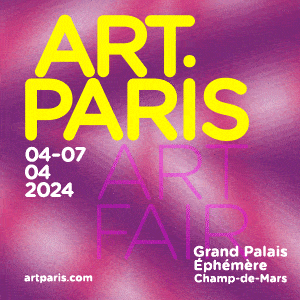Whitehot Magazine
April 2024
"The Best Art In The World"
"The Best Art In The World"
April 2024
Painting Poetically: A Conversation with Donna Moylan
 Donna Moylan, The Population of Europe, 2015. Acrylic, ink, gesso and charcoal on linen-, 78 x 96 inches. Courtesy the artist
Donna Moylan, The Population of Europe, 2015. Acrylic, ink, gesso and charcoal on linen-, 78 x 96 inches. Courtesy the artist
By PAUL LASTER, JUL. 2016
Raised in Boston, artist Donna Moylan visited Rome on a school trip in the 1970s and ended up staying more than 20 years. Influenced by both the old and the new art of Europe she developed her skills as a painter and began showing her work with such venerable art dealers as Mario Diacono and Gian Enzo Sperone. Moving to New York in 1992, Moylan exhibited regularly at galleries in SoHo and Chelsea—including Postmasters, Nicole Klagsbrun and Michael Steinberg—before assuming a more nomadic existence, splitting her studio time between New York City, Upstate New York and Pasadena, California. Recently shifting from the West Coast to a new residence in Houston, Moylan took time between traveling to discuss her life and work, which are completely interwoven.
Whitehot Magazine: What motivated you to become an artist?
Donna Moylan: Our house growing up was right on the Arnold Arboretum in Boston. In those days hardly anyone went there. The Arboretum was just trees and fields and hills and ponds. I was free and close to nature whenever I wanted, in any kind of weather.
I was constantly in the Museum of Fine Arts or the Gardner [The Isabella Stewart Gardner Museum]. My parents gave us carfare to go where we liked in the city, even when we were quite young.
I could draw, an apparently innate skill like ice-skating, that I downplayed but which made teachers shove me into special classes and programs.
The eldest and only girl of five children, my father treated me like a friend. I understood also—by the way he taught me—that he expected me to be as competent with tools as any male he knew, or more so. I am not particularly good with tools—except for a few—but his confidence in me was a gift. In addition, I sensed that through art I could get out of reach of my mother.
I hoped that art would be a means of self-discovery, especially when I was young. Later, I thought art was a means to improve human life on earth—the mover of culture. I'm not sure if that's true. I thought that art could encourage self-awareness. It does.
WM: When did you first start showing your work and how did exhibiting it impact what you were making?
DM: I started showing my work in around 1985, with Mario Diacono in Rome. It’s hard to say what affect it had on my work to show it. However, perhaps coincidentally, I became interested in employing other materials, like huge panels of wood with interesting grain, which I filled in with color and that became the background to the image, or slate blackboard, that I used as a literal “tabula rasa.” To show was galvanizing because the work was seen and judged and measured against my peers. That will clarify your thinking!
 Donna Moylan, Actor, 2013. Oil and acrylic on linen, 84 x 76 inches. Courtesy the artist
Donna Moylan, Actor, 2013. Oil and acrylic on linen, 84 x 76 inches. Courtesy the artist
WM: You mention Rome. Were you living there when you started showing? What's your relationship to the city?
DM: I was living in Rome when I began to exhibit my work. First I showed with Mario Diacono, and then with Gian Enzo Sperone.
When I was still a student at the Museum of Fine Arts School in Boston I signed on to a flight to Rome organized by the school. I had no expectations, just wanted to get out of Boston. In fact, it turned out the flight was a charter. There was no tour or other scholastic ambition to the trip so when I got there I was on my own. However, I had an introduction to a musicologist who introduced me to other people and within a couple of days I had fallen in with a group of artists and intellectuals who were much older than me and already launched on their careers. I gave no further thought to the future. Instead of getting back on the plane after two weeks—as planned—I stayed.
Rome was gorgeous in a rundown, timeless way. Housing was cheap, the food was delicious and the feeling of being lost in time seemed to encourage conversation. No hurry, no rush. It was as if the whole city was a room set apart for a conclave.
Even though time seemed suspended, the place was absolutely specific. There was nothing like it.
Rome was a working town back then. Every conceivable space was alive with people making things. The center was full of gilders, jewelers, tailors, awning makers, leather workers, mosaicists, inlayers, stonemasons, mattress makers, carders—you name it—along with stores supplying the materials. Open any door, walk into any courtyard in any street or alley and you’d step into the workshop of a specialist—craftspeople at the top of their game, among the best on earth. They were curt, friendly, at ease with themselves.
It looked as though things were going on as they had forever—in a setting of indescribable magnificence. If it seemed the inhabitants took it for granted, they didn’t. The Second World War was living memory still, in the seventies, continually referred to—though Romans have a familiarity with many wars. Over the decades I lived there and spoke Italian I realized that the Romans refer casually even to wars from centuries past.
I was lucky. I lived in beautiful, high apartments in the ancient city—got them cheap, kept them long. You had a hundred stairs but you had room and views. Gradually the city was no longer a backdrop for me. I learned the architecture, the paintings, the archeology. The main thing was that the artists who had made the city over the many centuries became vocal. I mean I began almost to observe the dialogue among them. The domes, the Piazza Navona, the obelisk in Piazza del Popolo, the cornices of the churches began to make sense to me. I actually felt and told myself as it happened that it was like stepping through a membrane. What had been opaque became vivid.
My relationship to Rome was long and deep. As an artist it taught me three things: 1) that to make something requires work, 2) that the sensual life—food, love, conversation—is sane, and 3) there are times we kind of wake up and realize we are participating in a project that’s been going on forever. I took the opinion that culture contributes to living peaceably.
 Donna Moylan, Tumulus, 2013-14. Oil and acrylic on linen, 84 x 96 inches. Courtesy the artist
Donna Moylan, Tumulus, 2013-14. Oil and acrylic on linen, 84 x 96 inches. Courtesy the artist
WM: What kind of artwork were you making and showing?
DM: In Rome my work was very conceptual. Partly in response to a perceived decree against women’s capacity to paint, I was gradually becoming aware of those particular years’ significance within the male-dominated "History of Art." What was determining that chain of command through the ages? In addition there was a suspicion among the intelligentsia that painting, per se, was in any case a bourgeois activity—retrograde in a post-war world that in Italy, at least, held hopes of becoming post-capitalist.
If I did paint, what could be the subject matter? My decision was to make paintings that were different from one another. Authorship was immaterial; what was important was the unconscious recognition that could occur in looking at a work of art. In other words, I wanted to reaffirm the existence of that particular experience. I was stating that art is a phenomenon, that we are primed for it, and that it can be prompted. If the paintings look different from one another—one abstract, another figurative, some with words, other with landscapes, some funny, some grave and so on, to my mind I was dissolving the problem of authorship and formalism. The subject matter was art itself. Not so much painting, although some paintings were self-referential, it was the experience that I was after. In a way, putting aside the question of my gender, my solution or proposal might have been easier if I’d been making sculptures; but I had almost no money, so I was making paintings. To make my case with painting was both harder and more fun.
Naturally, the gallerists who were interested in my work were distressed. Although he was the first to show my work, I had endless arguments with Mario Diacono, all over Europe. He kept expecting—almost insisting—that I settle down into a style. I didn’t want to. “Look, Picasso did one painting different than another,” I’d point out. “Not at the same time!,” he declared. Meekly, I showed him two Picasso paintings from the same year— in museums in Germany or in New York or in Paris, for example—but I was getting nowhere. The only one who understood was Gian Enzo Sperone, and I just don’t know why.
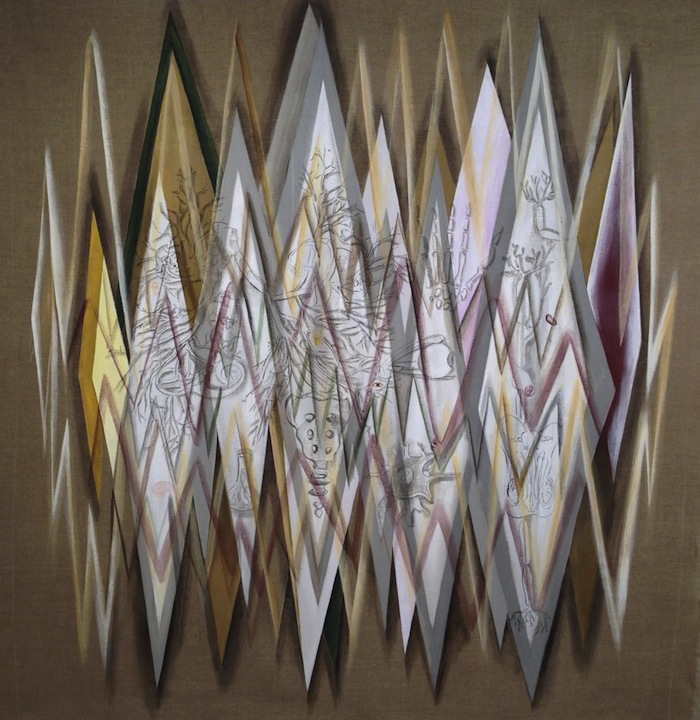 Donna Moylan, Corpus mentis, 2014. Acrylic on linen, 48 x 48 inches. Courtesy the artist
Donna Moylan, Corpus mentis, 2014. Acrylic on linen, 48 x 48 inches. Courtesy the artist
WM: Besides being different in content and style, there are certain psychological, metaphysical and surreal qualities to your paintings. Who are your influences?
DM: Your observation that my work has surrealist or mystical aspects really makes me wonder! Does it? I guess it does!
Day to day, I’m attracted to different kinds of art according to what interests me at any given time; but if I stop to examine your question I have to admit that temperament, psychology or personal life experience must lead to certain affinities.
Maybe your very question will bias me, but here goes.
I’m scanning my memory. I see a lifetime of looking at art—stretching like a huge plain to a far horizon. Back there, like the background radiation at the dawn of the cosmos, I was certainly influenced by Jung, and Margaret Mead, and Buddhism. Then there’s a massive muddle of everything and a long stretch of European art. Search, search…things pop up for attention: Installations by Jonathan Borofsky, Paul Thek. A memory of being gobsmacked by the Sidney Nolan exhibit at the Metropolitan Museum years ago—so direct, so clunky and crazy: the Ned Kelly series. Picabia marches in, Alberto Savinio and Max Ernst and other shifting sensibilities like Polke, some of the ambitious Transavantgarde [the Italian version of Neo-expressionism], Louise Bourgeois, artists I admire like Not Vital, Saint Clair Cemin, and in more recent years, Raymond Pettibon, which makes me think of Marcel Dzama (after the show they did together, though each stands alone). See, now it gets random.
I sidestep Picasso, then he WACKS ME ON THE HEAD, I mean, he’s impossible to ignore. In my formative years Picasso was so taken for granted (at the same time he was revered) that it was almost stylish to ignore him, not to say discount him. You may run, but you can’t hide; his paintings would virtually reach out from the wall and bop you on the noggin when you least expected it.
I have loved wacky Pontormo, scary Tintoretto and stately, still works, like the majestic Piero madonnas or the astounding Bellinis. So yes, the blends and combinations do point to art with a sense of wonder and humor, and a taste for a kind of intimate surprise—the kind you can get from a joke or a mystical epiphany—or the sublime.
However, those words are tricky. I don’t really like "the surreal" in art, strictly speaking. It can be both too literal and too hermetic. Dreams are personal, therefore usually unavailable to others, i.e. dull (although it’s fair game to borrow fine imagery, if it is provided). The term “mystical” makes me nervous, close to religious terminology. “Sublime” is tricky, too; couldn’t the term be employed—if misappropriated—to ideological ends? If we say “Sublime” we have to say it with a drawl, or a whisper.
I want to be caught by surprise, I want art to suspend judgment, suspend time, make me think, open me to intuition—art that ties us humans together in shared experience across eras and over a lot of geography, a combination of a cosmopolitan, international, awareness with a gutsy sense of wonder at life on earth. I guess it's a combination of wonder and humor with a dose of driving, grim acceptance.
I have to describe myself as a Western artist. I studied Asian and African art for years, but I have to suppose that although it dwells within me somewhere I cannot cite it in any direct way, except to understand that I and we would be nowhere without it.
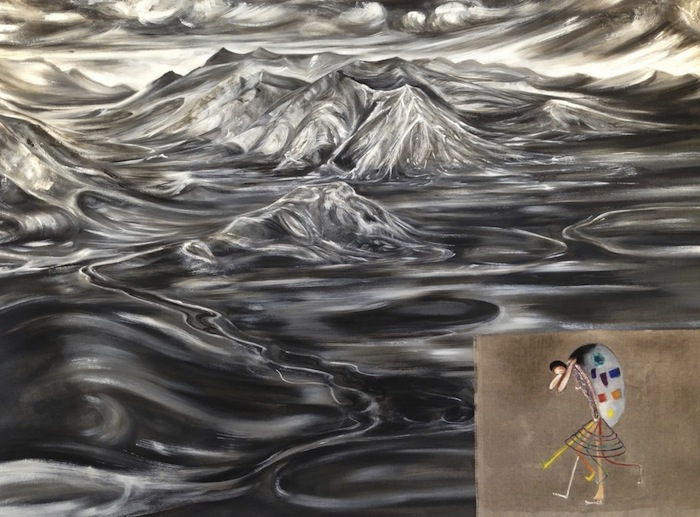 Donna Moylan, The Color Bearer, 2013. Oil-on-linen, 38 x 51 inches. Courtesy the artist
Donna Moylan, The Color Bearer, 2013. Oil-on-linen, 38 x 51 inches. Courtesy the artist
WM: Okay, we've established that you work in different styles and have numerous influences; what about the aspect of your life being nomadic and your working from different studios at different times over the past 15 or 20 years. How does that impact your work?
DM: Sometimes it is disorientating to travel so much and to work in different studios; certainly, when I get a row of good solid days in the studio I go into a kind of productive meditation. However, going from one studio to another after periods of absence means seeing the work fresh—catching a detached glimpse of it. A solution to a problem becomes apparent, or a piece calls out for more attention. You have to sneak up on paintings sometimes, catch them unaware.
This is all fine and good, even a boon. The problem for me is it indulges part of my temperament that loves to be alone working. I tend to create "work gardens" for myself, where I lose a sense of time. Then all of a sudden I look up and wonder where the other humans are, where the other ARTISTS are, and I’m gripped by the worry that I’m missing something—the way you can be lost in a book or a newspaper while a party is going on around you.
I love the art world; I like having shows. How the art world does business is a perpetual mystery to me, even after all these years; but I do think that gallery dealers have to know where to find you. If you stay in one place you make it easier for them. So in my case it’s up to me. I keep reminding myself that part of my responsibility is to let people know I’m here—I’m making art. WM
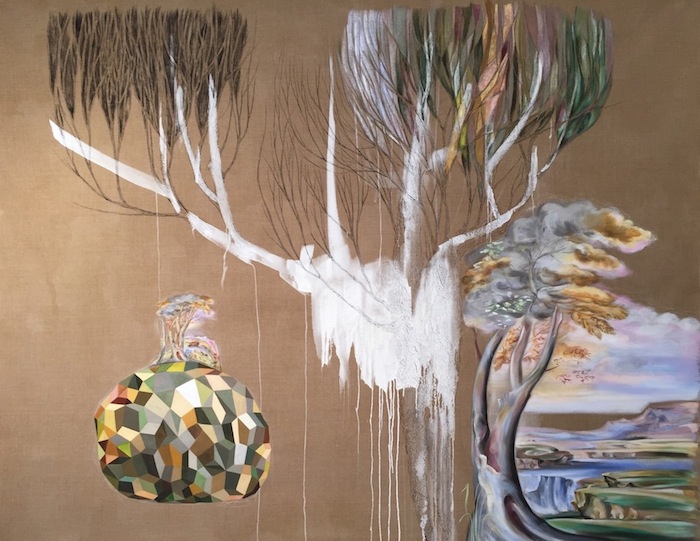 Donna Moylan, The Common Era, 2015. Acrylic, pastel and ink on linen, 78 × 92 inches. Courtesy the artist
Donna Moylan, The Common Era, 2015. Acrylic, pastel and ink on linen, 78 × 92 inches. Courtesy the artist
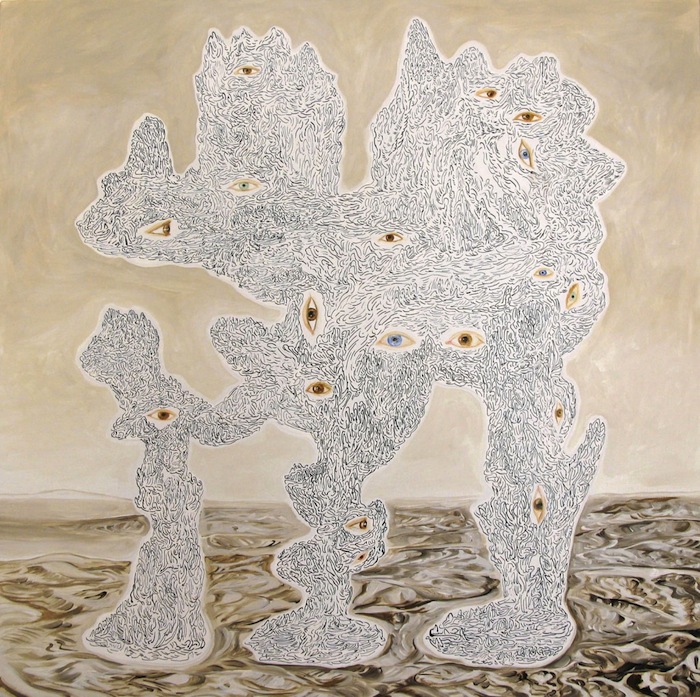 Donna Moylan, Land Walk, 2012. Oil on canvas, 24 × 24 inches. Courtesy the artist
Donna Moylan, Land Walk, 2012. Oil on canvas, 24 × 24 inches. Courtesy the artist
 Donna Moylan, Future City, 2008. Oil on canvas, 53 × 71 inches. Courtesy the artist
Donna Moylan, Future City, 2008. Oil on canvas, 53 × 71 inches. Courtesy the artist
 Donna Moylan, Tower of Babel, 2008. Oil on linen, 48 × 60 inches. Courtesy the artist
Donna Moylan, Tower of Babel, 2008. Oil on linen, 48 × 60 inches. Courtesy the artist

Paul Laster
Paul Laster is a writer, editor, curator, artist and lecturer. He’s a contributing editor at ArtAsiaPacific and Whitehot Magazine of Contemporary Art and writer for Time Out New York, Harper’s Bazaar Arabia, Galerie Magazine, Sculpture, Art & Object, Cultured, Architectural Digest, Garage, Surface, Ocula, Observer, ArtPulse, Conceptual Fine Arts and Glasstire. He was the founding editor of Artkrush, started The Daily Beast’s art section, and was art editor of Russell Simmons’ OneWorld Magazine, as well as a curator at P.S.1 Contemporary Art Center, now MoMA PS1.
view all articles from this author






